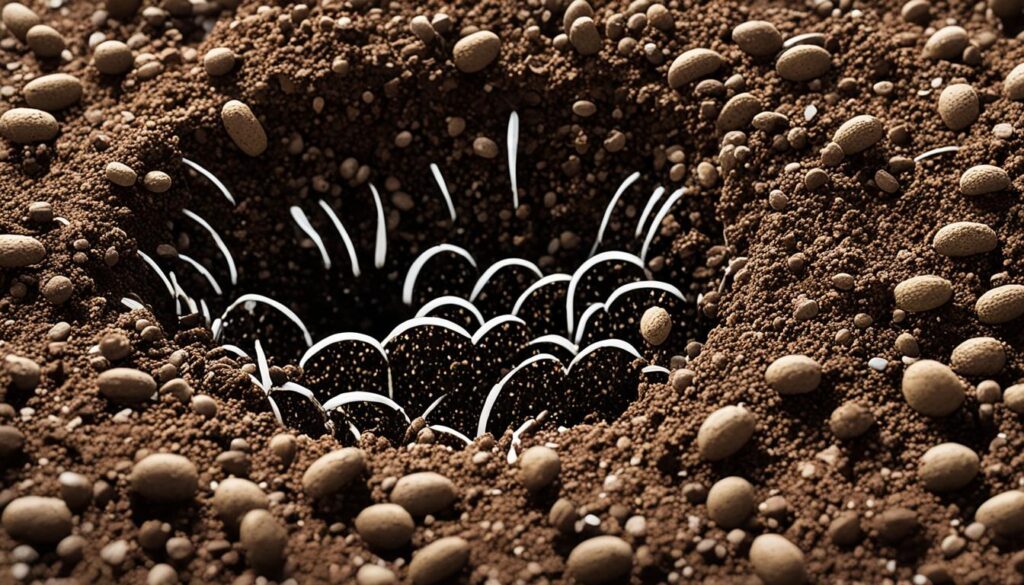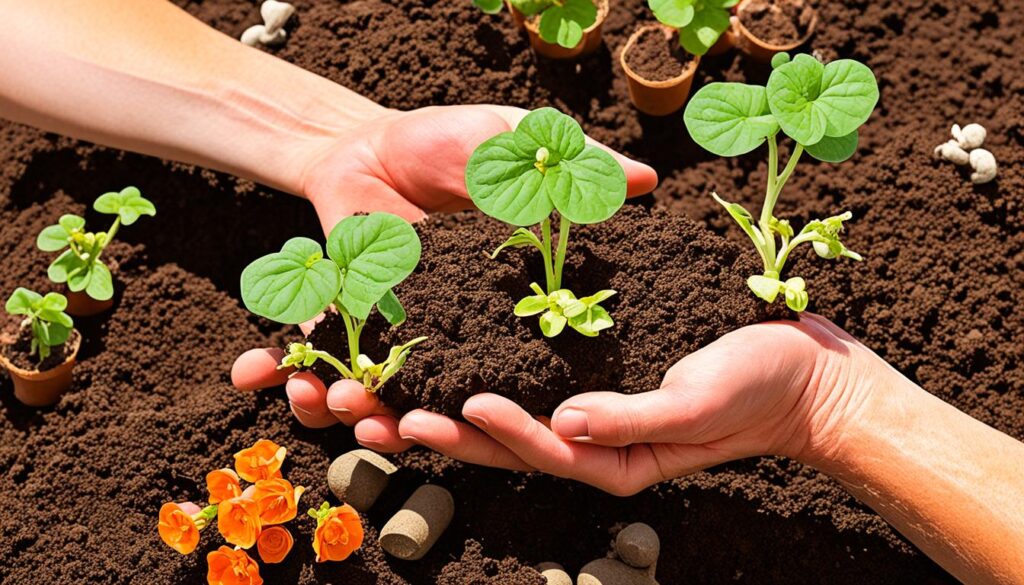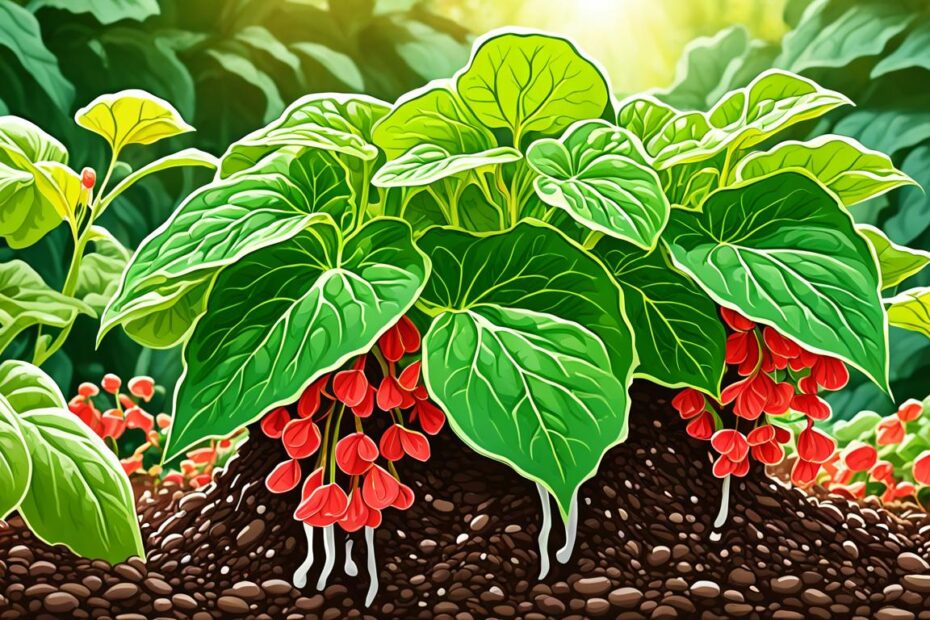Are you struggling to make your begonias thrive and produce vibrant blooms? The secret lies in the soil. Understanding the ideal soil characteristics for begonias is crucial to their overall health and vitality. So, what is the best soil for begonias?
Begonias flourish in loose, well-draining soil with a slightly acidic to neutral pH level. This type of soil provides the perfect balance of moisture and allows the roots to access essential nutrients. But that’s not all. The ideal begonia soil should also be rich in organic matter and nutrients, ensuring a nourishing environment for these beautiful plants.
Creating the perfect soil environment for begonias may sound like a daunting task, but fear not! In this article, we will explore the characteristics of the ideal begonia soil, give you tips on preparing it, and provide maintenance and growth tips for begonia tubers. Get ready to transform your begonias into vibrant, blooming beauties!
Key Takeaways:
- Choose loose, well-draining soil for begonias.
- A slightly acidic to neutral pH level is ideal for begonias.
- Enrich the soil with organic matter and nutrients.
- Proper drainage and aeration are crucial for begonias’ health.
- Prepare the soil according to the characteristics mentioned above.
Understanding Begonia Tubers
Begonia tubers are underground storage organs that play a vital role in the plant’s growth cycle. These fleshy structures store energy and nutrients, allowing Begonias to survive adverse conditions and thrive in varying environments.
During the growing season, Begonias utilize these tubers to store nutrients and water, ensuring continuous growth and development. The tubers act as a reservoir, providing the necessary resources for sustained vitality and blooming.
However, when conditions become unfavorable, Begonias enter a dormant phase. This is a natural survival mechanism that allows the plant to conserve energy and prepare for times of stress. During the dormant phase, the tubers serve as a source of stored energy, enabling Begonias to survive until favorable conditions return.
When conditions improve, such as the arrival of spring or a change in environmental factors, the dormant tubers awaken and initiate new growth. The stored energy and nutrients within the tubers are utilized to fuel the development of leaves, stems, and flowers, leading to a vibrant and healthy Begonia plant.
Key Points:
- Begonia tubers are fleshy underground storage organs.
- They store energy and nutrients for the plant’s growth cycle.
- Tubers are utilized during the growing season for nutrient storage.
- During the dormant phase, tubers provide the energy for survival.
- Tubers play a crucial role in the resumption of growth when conditions become favorable.
Characteristics of Ideal Begonia Soil
To ensure the vibrant growth and blooming of your Begonias, it is essential to provide them with the ideal soil characteristics. The quality of soil directly impacts the health and vitality of your plants. Let’s explore the key characteristics that make up the perfect soil for Begonias:
Texture and Structure
The texture and structure of the soil play a crucial role in the overall development of Begonia roots. Ideally, the soil should have a loose, friable texture that allows for proper root penetration and water infiltration. Sandy loam or loamy soil types are generally considered the best choices for Begonias.
pH Levels
The pH level of the soil is another crucial factor to consider. Begonias prefer slightly acidic to neutral soil with a pH range of 6.0 to 7.0. Maintaining the appropriate pH level ensures optimal nutrient availability for your plants.
Organic Matter and Nutrients
Begonias thrive in soil that is rich in organic matter and nutrients. You can enhance the soil’s fertility by incorporating compost or well-rotted organic materials. These additions provide essential nutrients and enhance soil structure, promoting healthy growth and vibrant blooms.
Drainage and Aeration
Proper drainage and aeration are vital for Begonias’ overall health. Good drainage prevents waterlogged conditions, which can lead to root rot, while adequate aeration ensures that the roots receive sufficient oxygen. Together, they promote healthy root development and prevent waterlogged soil.
“Creating the perfect soil environment for Begonias is necessary for their overall health and vitality.”
| Soil Characteristic | Description |
|---|---|
| Texture and Structure | Loose, friable texture for proper root development and water infiltration; sandy loam or loamy soil; |
| pH Levels | Slightly acidic to neutral (6.0 to 7.0) |
| Organic Matter and Nutrients | Soil rich in organic matter and nutrients; incorporate compost or well-rotted organic materials for fertility |
| Drainage and Aeration | Good drainage to prevent waterlogged conditions; adequate aeration for oxygen supply to the roots |
Providing the ideal soil characteristics is fundamental to the success of your Begonia cultivation. It ensures optimal root development, nutrient absorption, and overall plant health. Now that we understand the characteristics of ideal Begonia soil, let’s explore how to prepare the perfect soil for your Begonias in the next section.

Tips to Prepare the Ideal Soil for Begonias
Before planting Begonias, it is crucial to ensure that you have the ideal soil conditions for their growth. Here are some tips to help you prepare the perfect soil for your Begonias.
Soil Test
Begin by conducting a soil test to determine the pH level and nutrient content of your soil. A soil test will provide valuable insights into the current condition of your soil and help you make necessary adjustments.
pH Adjustment
Based on the results of the soil test, you may need to adjust the pH level of your soil. Begonias prefer a slightly acidic to neutral pH. If your soil is too acidic, you can raise the pH by adding lime. Conversely, if your soil is too alkaline, you can lower the pH by adding sulfur.
Organic Matter Amendment
Enrich your soil with organic matter to improve its fertility and structure. Add compost or well-rotted manure to enhance the soil’s nutrient content and water-holding capacity. Organic matter also helps to improve soil aeration and drainage.
Soil Sterilization
Before planting Begonias, consider soil sterilization methods to eliminate harmful pathogens and pests. Pasteurization or solarization can be effective techniques to ensure a healthy growing environment for your plants.
Sanitation Practices
Maintaining good sanitation practices in your garden is essential to prevent future issues. Remove debris, weeds, and diseased plant material regularly to minimize the risk of diseases and pests affecting your Begonias.
| Tips to Prepare the Ideal Soil for Begonias |
|---|
| Conduct a soil test to determine pH and nutrient levels. |
| Adjust the pH level of your soil using lime or sulfur. |
| Enrich the soil with organic matter like compost or well-rotted manure. |
| Sterilize the soil using pasteurization or solarization methods. |
| Maintain good sanitation practices by removing debris and diseased plant material. |
By following these tips, you can create the ideal soil conditions for your Begonias, promoting healthy growth and vibrant blooms.
Maintenance and Growth Tips for Begonia Tubers
To ensure robust growth and vibrant blooms in Begonia tubers, it is essential to incorporate effective maintenance practices into your gardening routine. By following these simple yet impactful tips, you can create an optimal environment for your Begonias to flourish.
Fertilization
Regular fertilization is key to providing Begonia tubers with the necessary nutrients for healthy growth. Use a balanced, water-soluble fertilizer specifically formulated for flowering plants. Follow the instructions on the packaging for proper application and dosage. Fertilize your Begonias every two to four weeks during the growing season to promote lush foliage and abundant blooms.
Mulching
Mulching is an effective technique to retain moisture in the soil, suppress weeds, and regulate soil temperature, providing Begonia tubers with the ideal conditions for growth. Apply a layer of organic mulch, such as shredded bark or compost, around the base of your plants. This will help conserve moisture, reduce water evaporation, and protect the delicate roots.
Pest and Disease Control
Regular inspection is crucial for early detection of pests and diseases that can harm Begonia tubers. Conduct frequent visual inspections of the leaves, stems, and flowers, looking out for any signs of stress or infestation. If any issues are identified, take immediate action to prevent further damage. Use organic or chemical pest control methods, depending on the severity of the infestation, ensuring the health and integrity of your plants.
Regular Inspection
Regularly inspecting your Begonia tubers allows you to identify any potential problems early on, ensuring timely treatment and a healthier plant. Look for signs of stress, including wilting leaves, discoloration, or abnormal growth patterns. Check for any signs of pests such as aphids, mealybugs, or spider mites. Monitor for diseases such as powdery mildew or fungal infections. By catching issues early, you can take the necessary measures to revive your Begonias.
Maintenance Practices
In addition to fertilization, mulching, and pest control, other maintenance practices are essential for the successful growth of your Begonia tubers. Remove any dead or yellowing leaves regularly to maintain a neat and tidy appearance. Prune back overgrown stems to encourage bushier growth. Ensure your plants receive adequate water and maintain consistently moist, but not waterlogged, soil. Proper watering practices help prevent root rot and ensure optimal health.
| Maintenance Practices for Begonia Tubers | Recommended Frequency |
|---|---|
| Fertilization | Every 2-4 weeks during the growing season |
| Mulching | Apply once after planting, refresh as needed |
| Pest and Disease Control | Regular inspection, immediate action when necessary |
| Regular Inspection | Weekly |
| Maintenance Practices | Ongoing |
By implementing these maintenance and growth tips, you can ensure that your Begonias thrive and reward you with stunning displays of vibrant colors and exquisite blooms. Stay vigilant in caring for your Begonia tubers, and your efforts will be rewarded with a flourishing and visually captivating garden.

Meeting Begonias’ Light Requirements
Begonias, with their exquisite blooms and lush foliage, require specific light conditions to thrive and flourish. Understanding their light requirements is essential for successful cultivation. Providing the right amount and quality of light will ensure the optimal growth and development of your begonias.
Many begonia varieties prefer bright, indirect light to thrive. These plants thrive in locations that receive filtered sunlight or partial shade. Placing your begonias near windows with sheer curtains or in areas that provide bright, indirect light will provide them with the ideal conditions they need to flourish.
It is crucial to avoid exposing your begonias to direct sunlight. Direct sunlight can be too intense and damaging for their delicate leaves, causing leaf burn or discoloration. To protect your begonias, choose locations where they are shielded from direct sunlight, such as under trees or in partially shaded areas of your garden.
In situations where natural light is limited, supplemental grow lights can be used to provide the necessary light spectrum for healthy begonia growth. These grow lights mimic natural sunlight and can be set to provide the optimal light intensity and duration. Supplemental grow lights are particularly beneficial during the winter months when natural light levels are lower.
“Proper lighting is fundamental to begonia growth. Bright, indirect light and shade tolerance are crucial for their overall health and vitality.”
Watering Begonias: Finding the Perfect Balance
Proper watering is essential for the health and vitality of Begonias. To keep your Begonias thriving, it is crucial to understand the right watering techniques, soil moisture levels, drainage, and watering quantity.
Before watering your Begonias, check the soil moisture levels. The soil should be slightly dry to the touch before watering. This ensures that the roots have proper access to oxygen and prevents the risk of overwatering.
While Begonias prefer moist soil, it is important to avoid waterlogged conditions. Excessive moisture can lead to root rot and other complications. Ensure that the soil has adequate drainage to prevent water from pooling around the roots.
When watering your Begonias, it is recommended to thoroughly saturate the soil. This allows the water to reach the deeper roots and ensures proper hydration. Avoid surface watering, as it may not penetrate deep enough.
A watering schedule of once every 7-10 days is typically sufficient for Begonias. However, it’s best to adjust the frequency based on the moisture needs of your specific plants. A general rule of thumb is to water when the top inch of soil feels dry to the touch.
Remember that overwatering can be just as harmful as underwatering. It’s important to find the perfect balance to promote healthy growth and prevent waterlogged soil.
“Finding the right balance of moisture for your Begonias will ensure their overall health and vibrant blooms.”
| Watering Techniques | Key Benefits |
|---|---|
| Thoroughly saturate the soil | Ensures proper hydration and allows water to reach the deeper roots |
| Check soil moisture levels | Prevents overwatering and ensures adequate oxygen for the roots |
| Avoid waterlogged conditions | Prevents root rot and other complications |
| Adjust watering frequency | Allows for customization based on the moisture needs of your Begonias |
By following these watering techniques and maintaining the right soil moisture levels, you can provide optimal conditions for your Begonias to thrive. Remember to pay attention to the drainage, avoid waterlogged soil, and adjust your watering schedule accordingly. Finding the perfect balance will result in healthy, vibrant Begonias that bring beauty to your garden or indoor space.
Conclusion
Understanding and providing the best soil for Begonias is crucial for their vibrant growth and blooming. The ideal soil characteristics include a loose, well-draining texture, a slightly acidic to neutral pH level, rich in organic matter and nutrients, and ensuring proper drainage and aeration. By preparing the soil according to these characteristics and following maintenance and growth tips, Begonia tubers can thrive and produce beautiful blooms year after year.
Embrace the joy of nurturing these remarkable plants and enhance the visual aesthetics of your home and garden. With the right soil conditions and proper care, your Begonias will flourish and become a stunning centerpiece in your outdoor spaces. Whether you choose to grow them in containers or in garden beds, the vibrant colors and exquisite blooms of Begonias will bring endless beauty to your surroundings.
Remember to conduct a soil test and make the necessary adjustments to create the ideal environment for your Begonia tubers. Incorporate organic matter and provide regular fertilization to ensure they receive the nutrients they need. Proper watering and monitoring for pests and diseases will help your Begonias stay healthy and thrive.
Get ready to experience the rewards of gardening as you watch your Begonias grow and bloom. Let the beauty and serenity of your garden be an inspiration and a source of happiness in your life. Happy Gardening!
FAQ
What are the ideal characteristics of soil for begonias?
The ideal soil for begonias should have a loose, well-draining texture, a slightly acidic to neutral pH level, and be rich in organic matter and nutrients. It should also provide proper drainage and aeration.
How do I prepare the ideal soil for begonias?
Before planting begonias, it is recommended to conduct a soil test to determine pH and nutrient levels. Based on the analysis, pH levels can be adjusted with lime or sulfur, and organic matter like compost or well-rotted manure can be added. Soil sterilization methods, such as pasteurization or solarization, can eliminate harmful pathogens and pests.
How often should I water my begonias?
The soil should be checked for moisture levels before watering, and it should be slightly dry to the touch. Begonias prefer moist soil but should not be waterlogged. Thoroughly saturate the soil when watering, and a watering schedule of once every 7-10 days, or when the top inch of soil feels dry, is generally sufficient.
What light conditions do begonias prefer?
Many begonia varieties prefer bright, indirect light and should be placed in locations that receive filtered sunlight or partial shade. Some varieties are more shade-tolerant and can be grown in rooms with limited natural light. Direct sunlight should be avoided as it can damage the leaves.
